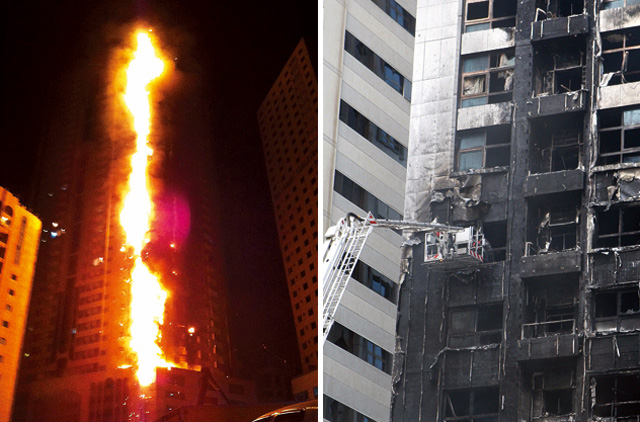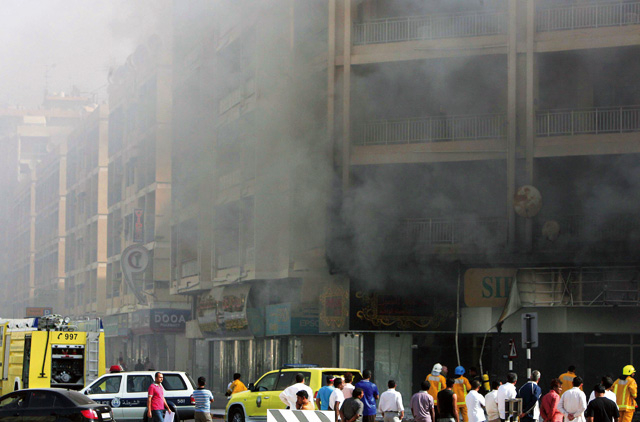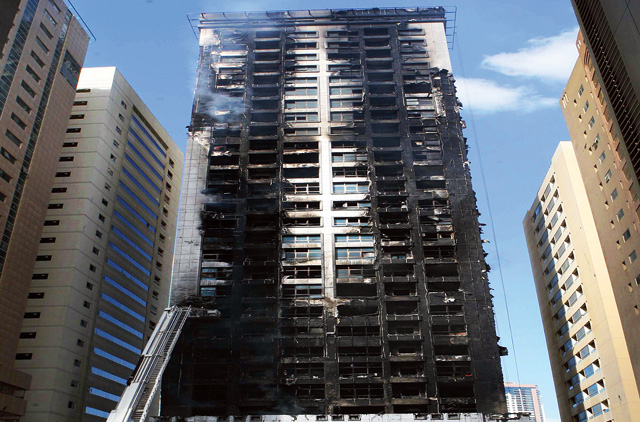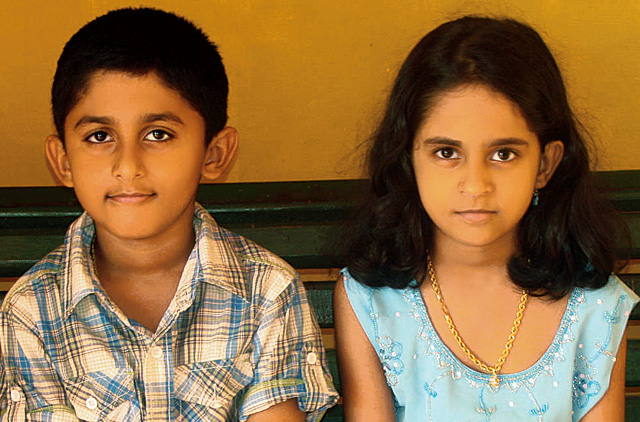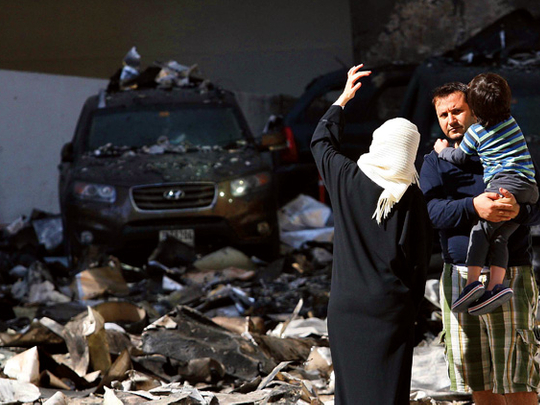
Every night 11-year-old Jade* wakes up screaming and drenched in a cold sweat. "Another nightmare?" her mother Shilpa* gently asks, wrapping her daughter in a hug. The little girl has been plagued by night terrors, which leave her sobbing and shaking, for the last two weeks - ever since watching her apartment go up in smoke. The fire, that engulfed one part of the Al Tayer Tower in Al Nahda, Sharjah, at around 2.30 am on April 28, not only destroyed everything she and Shilpa (*names changed on request) owned, it also took her pet cat Spike. "She and I tried all we could in those few minutes we had to get him out with us," says Shilpa, her voice catching. "But he panicked, hid in the bathroom and refused to come out when we called him." That was the last they saw of the tabby.
When Shilpa was finally allowed up to her burnt out apartment on the 25th floor, two days later, she couldn't bring herself to look for Spike. "The worst part is Jade refuses to talk about him," she says, "She obviously knows what must have happened to him, but its too painful to discuss."
Jade's not the only child who's traumatised by the blaze's devastating effect on the lives of around 2,500 people who lost almost all their belongings. The three-hour fire which reportedly started from the first floor destroyed nearly everything inside 102 of the 408 apartments in the 40-storey building which includes a six-level car parking. "My seven-month-old baby, Flor, has not stopped crying since being buffeted by the smoke and crowds when we rushed down 20 floors early that morning," says resident HD, (name withheld on request), Filipino supervisor in a major supermarket chain. "Now she becomes very fidgety and starts screaming even when we get into an elevator that's full. I wonder how long it will be before she calms down."
HD and his wife, holding their baby in her arms, had to exit the blazing building down the stairs from the 33rd floor. "Going down the first 15 floors was alright, though tiring," he says. "But from the 18th floor down it was a real nightmare. Everybody started to feel the heat and there was the burning smell that made us all panic." The smoke and smell of fear led to crying and shouting as the residents pushed their way down. "It was jam-packed all the way down," he says. Flor had stopped crying by the time they reached the ground floor. "She buried her head in my armpit, and refused to come out for more than an hour later," says HD, distress still showing on his face. Now, she keeps waking up every now and then when she falls asleep, and hides herself in her parents arms.
Every parent has similar stories to relate. Talin Ragesh, 10, is terrified of going back to his house. "He told me he just doesn't want to see the apartment ever again," says his father Rageshkumar A.V. who was a resident of apartment number 1004, that thankfully was not in the left wing of the building that caught fire. But the fear and trauma they suffered was no less.
Talin and his twin sister Teertha were terrified by the flight down the stairwell in panic just after being woken up by their mother Seeba Ragesh. With hundreds of people rushing down, many with children in their arms, there was no time for niceties. People who were polite to them every day pushed past in growing panic. "Chaos reigned everywhere," recalls Rageshkumar, 44, a health and safety consultant with the Al Mansoori Group. "And the kids were really worried,'' he says. "They were in tears and extremely tense. They were holding my hand tightly and keeping close to me and my wife especially after we exited the building.
"Now, more than a fortnight later, the fear appears to be still in them. They look worried and are jumpy. I'm not sure how I'll deal with it but I guess they'll get better over time,'' he says. (see box on helping children cope with trauma on pageXXX)
Residents of nearly 400 apartments of the residential building had to spend the next few hours standing and staring at their apartments going up in flames. The fire was extinguished by 5:30am while the cooling process took several hours. A total of 45 vehicles belonging to residents were also destroyed in the fire, according to a Gulf News report.
There are no reports of anyone sustaining injuries in the fire although it's likely that many could be at risk of suffering from post traumatic stress disorder.
"Several residents in the building who are affected by the fire are just waiting for the evaluation of the damages in the apartments to be completed before moving home. It's literally been a trial by fire for us," says Rageshkumar, when Friday met him a few days after the calamity.
Most victims of the fire at Al Tayer building narrate similar tales. They all line up outside the building, staring up at their apartments that have been blackened by the fire, dressed in ill-fitting casual clothes borrowed from their friends or bought hastily off the rack from the nearest supermarket.
"You see them every day first thing in the morning, standing just outside the tape put up by the police for safety, faces blank, eyes dull with shock, a hopeless look on their face, but still doggedly standing their ground as if they were hoping for a miracle that would wipe the tragedy away," says HD. Then he smiles, a little twisted twitch of his thin lips that doesn't quite reach his eyes. "Yes, I know, I am one of them, but when I stand here and look at them it's as if I am looking at them from the outside!"
At that moment a bit of metal, burnt beyond recognition, dislodges itself from one of the floors of the fire-blackened building and falls not too far from where we are standing with a loud clatter. HD jumps back, as do the people milling around the Al Tayer Tower.
While many of them accepted the hospitality of their friends and relatives that night and for many other nights, the less lucky ones found shelter in the temporary tents put up by the Civil Defence and organisations such as the Red Crescent at Al Nahda Park, a few hundred metres away from the building, in Sharjah. The two tents could accommodate around 50 people.
BK (name withheld on request), 37, is one of the luckier ones. He and his wife SK have two children, Dev, 9, and daughter Rekha, 4 and they are thankful the children are safe. The first thing he salvaged from his fire-ravaged apartment, after the authorities allowed tenants to return to their flats a few days after the tragedy, was his wife's gold jewellery worth around Dh25,000. It had been secreted away in her wardrobe in their bedroom that was luckily spared the blaze, though some parts of it are charred. "We hardly even thought about it when we'd rushed down six floors on the night of the fire," says a haggard looking BK. His wife is equally tired, and even the fact that they were able to salvage her precious jewels does not bring on more than a ghost of a smile on her face.
The scene of devastation at BK's apartment is horrible. The entire area is blackened. The television partly melted, forming a pool of black plastic at one end. Everything has been reduced to shell; only the frames of the sofas in the living room survive. Shattered glass, melted plastic, soot and ashes cover the entire apartment. The look on BK's face says it all. It is a wonder his wife's jewels survived the inferno.
It's been two weeks since the fire engulfed the left side of the Al Tayer Building and the BK family are still homeless, although thankfully not on the streets. "I am lucky I have a cousin in Abu Shagara who's been kind enough to put up with us," says BK. "But how long can we keep imposing on them?"
His phone keeps ringing with calls from real estate agents and friends who are searching for a house for him. "How much?" he ask brusquely. The price has gone up, he's told. What would have been available for Dh30,000 is now Dh34,000. Obviously, the supply has come down because of the demand. So, the hunt for a replacement home continues for BK and others whose apartments are no longer habitable.
While BK is considering renting another apartment, Jade's mum, Shilpa, cannot even think of looking for an apartment right now. She spent a lot re-furnishing her home recently. The new LCD television amd home theatre system, the new furniture and some appliances she'd bought set her back by around Dh15,000. With her jewels too gone, she can't drum up enough down payment for an apartment right away. "Though I've been in the UAE for the past 13 years I don't have a high profile job," she says, still shell-shocked. "I saw all my possessions go up in flames. I know all of us have our own heartbreaking stories, but it's hard to watch what you have go up in flames, while all you can do is stand by and look on helplessly. Plus we've lost Spike."
The single mother was alone with Jade and their cat on the fateful night. "We were asleep, but fortunately my nephew who stays in the building across ours saw the fire and called me on my mobile to tell me to rush out," she says. "We had less than a minute to get out of the place."
Shilpa, who's now living in her sister's apartment, had been on leave from her workplace for five days when we met her. "I can't do this indefinitely," she says in despair. "I've lost everything, now I can't afford to lose my job too."
Almost all the victims tell stories of how residents who'd been total strangers until the fire have now helped them cope. Even as we speak, a man comes and clasps BK's hands, "How are you, brother?" he says. "Is your family coping well?" They exchange notes warmly. After he moves away, BK realises he still doesn't know his name. "He helped us go down, and sit in his car," he says. "That was one wonderful thing that happened, everybody was helping whoever they could."
Ramshesh, 47, who works for Al Futtaim Carillion, and was a resident of 1109 in the building, speaks with feeling about how he and his family were helped to cope by their friends. "Our friends Ali and Aisha, who live in the building right across, put us all up in their house, and even provided us and our children daughter Sharanya, 10, and son Satchith, 15, with clothes," he says. "Other friends got in touch immediately and offered help. Another pair of friends, Kanish and Jaya, hosted us for a few days at their home too."
Except for a few, almost all the residents in the building left their flats that night with little more than their wallets and mobiles. Most of them were in their night clothes.
"Now I've realised that it's important to keep a set of clothes packed in a bag along with our important papers and some emergency money," says Rageshkumar. The reason is that most of them spent around Dh400 almost immediately for a set of clothes for the family at the nearest super market.
Shilpa's daughter Jade couldn't go to school because her books and uniforms had been destroyed in the fire. She only went back to The Westminster School five days later, thanks to her teacher who arranged for new books and uniforms, says Shilpa.
Returning to the apartments
Even as she is speaking, a security guard approaches the group of people who are waiting outside and starts reading out the names of the tenants who would be allowed to inspect their apartments. Everybody mills around him, refusing to disperse although only two persons are allowed up at one time. "The first time we went back we climbed up 25 floors, plus six floors of parking," says Shilpa. "A major workout. We don't need to go to a gym for a year at least!"
Humour is what most victims use to tackle their situation.
Jan B, 32, is now terrified of living in high rises. "I am now looking for a villa," he says. "I have a four-month-old daughter, Millie, and it was a nightmare carrying her down the stairwell with the almost stampede-like situation."
The smoke and burning smell almost made him panic, he says. "If anybody had pushed me I could have toppled over, with my child in my arms,"
It is for such situations that Rageshkumar feels that buildings should follow some set safety measures. "There were many old people, pregnant women and physically challenged who were forced to walk down the stairs," he says. "An elevator should be maintained for them. An expert in crisis management should take over and manage the panic-stricken victims to guide them down. In Abu Dhabi some buildings like the Adnoc buildings have installed several such emergency procedures. It would be impossible for people to walk down a building with 70-80 floors. There should be an emergency elevator where the power can be isolated and run on generator."
The safety expert feels in time all buildings would have to install fire retardant doors, and even look at the possibility of fire curtains, where a curtain made of fire retardant material will descend automatically in case of a fire to isolate it and prevent it from spreading.
But until that happens Rageshkumar would rather think of taking out household insurance. Almost none of the residents in Al Tayer Tower had insured their belongings. "I reckon I've lost around Dh75,000 worth of stuff in the fire," says a rueful Ramshesh. "It's taught me a lesson: as soon as I move to a new apartment I am going to invest in household insurance."
It's been a costly lesson. But as Shilpa says, "I mourn over all that I've lost. And then I look at my daughter's face and realise that we didn't lose the most precious things we have; ourselves. For that I am thankful."
Staff to the rescue
They had no protective gear, no real training, and no precise mandate except to serve the residents of the building. And yet, they went beyond the call of duty to attempt to get the residents of Al Tayer Tower out of the blazing building intact and unharmed.
Staffers of the building, including security in charge Hamid Mohammad and his deputy Shozem, cleaners Abu Bakr and Rahul, and about six others went up the 40 floors, banging on each door worried that some residents might ignore the fire alarm.
"We just went up and did what we had to," says Hamid simply.
"They did a great job," says HD, a resident of the building who was woken up by one of the cleaners. "They ran up and down, through the smoke and water, shouting at the top of their voices. I am sure the reason why there is no casualty is, at least in part, due to their diligence."
Helping children cope
Just as when children experience small personal disasters such as losing a favourite toy, being involved in a fight at school, or suffering an injury, meeting physical needs is only part of the solution, says psychotherapist Ellen Weber Libby, and author of the bestselling ‘The Favorite Child'. Children also have emotional needs; the need for reassurance, comfort, love and attention. The US-based expert offers advice on how to help children cope after a disaster:
- Talking about the event with children can decrease their fear. It's important to explain the event in words the child can understand, and at a level of detail that will not overwhelm them.
- Children are aware of their parents' worries most of the time, but they are particularly sensitive during a crisis. Parents should admit their concerns to their children, and also stress their abilities to cope with the disaster.
- A child's age affects how the child will respond to the disaster. For example, six-year-olds may show their worries by refusing to attend school, whereas adolescents may minimise their concerns, but argue more with parents and show a decline in school performance.
- Pre-school children (age 1 to 5) are especially troubled by the disruption of their previously secure world and they are very fearful of being abandoned. Parents should encourage expression through play reenactment, provide verbal reassurance and physical comfort, give frequent attention, and encourage verbal expression about loss.
- Children between the ages of five to 11 typically regress to more immature behaviour and find loss especially difficult to deal with. Treat them with patience and tolerance. Allow them to play with adults and peers, arrange discussion sessions with adults and peers, and allow temporary relaxation of expectation at school.
- Personal contact is reassuring. Hug and touch your children.
- Calmly provide factual information about the recent disaster and current plans for insuring their safety along with recovery plans.
- Encourage your children to talk about their feelings.
- Spend extra time with your children such as at bedtime.
- Re-establish your daily routine for work, school, play, meals, and rest.
- Involve your children by giving them specific chores to help them feel they are helping to restore family and community life.
- Encourage your children to help formulate/update a family disaster plan.
*names changed on request


